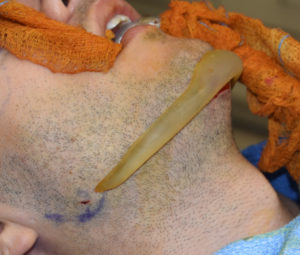Chin augmentation has been done for a long time and many different implant materials and shapes have been used. The most common chin implant used today is that of an extended or anatomic design. Rather than just sitting on the front edge of the chin this contemporary chin implant is anatomic as its side wings blend along and into the lateral jawline to the sides of the chin.
But as useful as the anatomic chin implant is, it does not augment much of the jawline behind it. It remains a front of the lower jaw augmentation method only.
An extension of the anatomic chin implant is what I call a chin-jawline implant. It is a chin implant that has winged extensions that go back all the way along the jawline…stopping just short of the jaw angle area. This creates greater definition of the jawline although not much width due to the thinness of the extensions.

The chin-jawline implant offers enhanced bone definition of the lower lateral border of the jawline. It is useful with jaw angle implants to create a total jawline augmentation effect, to improve jawline definition of a lower facelift and to extend the benefits of chin augmentation. It is available in male and female versions that differ in the shape of the chin with the male being more square and the female being rounded,.
Dr. Barry Eppley
Indianapolis, Indiana


